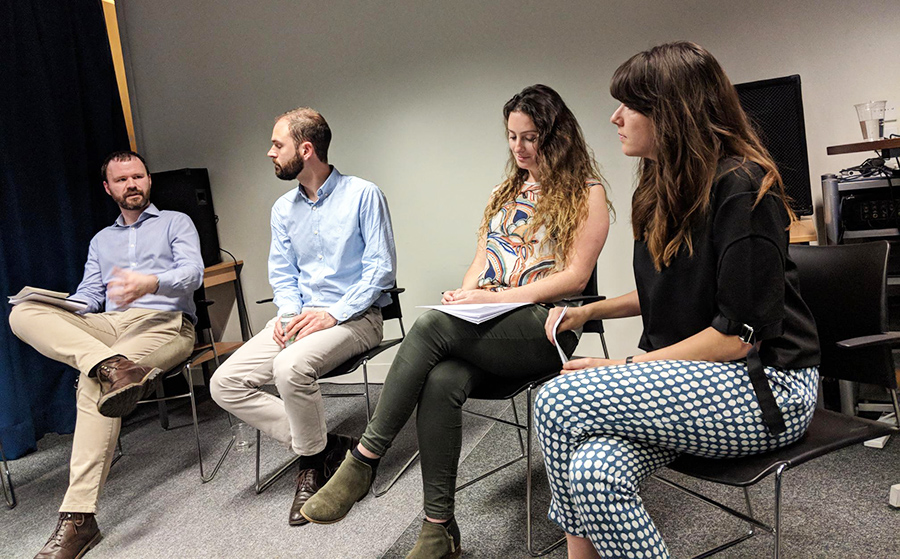Let us know what type of content you'd like to see more of. Fill out our three question survey.
Trends in Digital Health: 4 Takeaways From Our UK Event
Jun 11, 2018
In comparison to other development sectors, health programs have historically been early adopters of digital tools. What have we learned over the last 10 years, and where are we heading? How can we build systems that integrate data from independent actors across the health ecosystem? How can we use lessons learned to support innovation? How can we adapt to expanding digital access and support the growth of local capacity?

Panelists included Paula Quigley of DAI’s Health Partners International (not pictured), Andrew Toft, from left, of the U.K. Department for International Development, Nicolas Moreno de Palma of Simprints, Abi Gleek of Every1Mobile, and Chloe Messenger of DAI.
To address these questions, DAI recently hosted a panel discussion called “Digital Health in International Development: Current Realities and Future Trends,” as part of a series of UK events we’ve been hosting around the launch of our Center for Digital Acceleration (CDA). Chloe Messenger, CDA’s UK Digital Fellow, moderated the discussion, which featured Andrew Toft from the U.K. Department for International Development (DFID)’s Digital Team, Abi Gleek from Every1Mobile, Nicolas Moreno de Palma from biometrics nonprofit > Simprints, and Paula Quigley from DAI’s Health Partners International. Here’s a summary of the discussion:
1. We Need Data-Driven Systems, But Also Data-Driven Decision-Makers
It is clear that national health systems need improved processes and systems that ensure clean, accurate, secure, and timely health data. But, while we build these systems, we also need to make sure that decision-makers have the capacity and motives to act on this data. This will demand that we think beyond simply aggregating data into visualizations and dashboards—it requires building a data culture, not just within national and local governments, but also in development implementers and donors. It demands that we use data and evidence to coordinate donor efforts and avoid fragmentation, investing in data interoperability across donor projects, rather than building new systems.
2. Digital Tools Enable More Than Communication—They Create Community
It can be tempting for implementers and donors to think of expanding digital access in the Global South in a purely instrumental way, i.e. seeing mobile phones as either sources of health data or as channels for program outreach. But digital access is about so much more than simply sending or receiving information—it enables the creation and nurturing of local communities. This is the capability we should build on, whether to trigger behavior change such as handwashing and nutrition, or to track health outcomes.
3. Old Technologies are Just as Exciting as New Ones
It can be easy to get caught up in the hype of new technologies, but to innovate doesn’t just mean to create something new. We can use existing technologies in new and exciting ways, to drive more effective impact in the health sector and widen our reach. When the panelists were asked what technology they are most excited about, they all harked back to existing (and fairly well-established) technologies: clinical apps, where the opportunities for supporting community health workers are quickly evolving; systems to collect and process health data; open source data management platforms like DHIS2; and feature phones that help reach the ‘last mile’ of patients.
For some technologies such as blockchain, we are at the peak of the hype cycle, and there is a temptation to jump on the bandwagon and roll out pilots. But while these kinds of technologies are vital to the development of our sector, we need to balance this with the need to scale up and improve existing innovations. Simprints is a great example; the nonprofit has taken biometric technology and made the hardware robust enough for use in developing contexts, widening the reach of digital identity.
4. Despite Popularity of Human-Centered Design, We Still Need to do More to Understand Users
The concept of human-centered design (HCD) is not new to digital development, but our panelists and audience still managed to come up with several examples when technology design hasn’t been quite right: whether this be the use of text messaging for elderly farmers who can’t read, or apps for people who can’t afford smartphones. From DFID’s digital strategy, to the way Every1Mobile involves the beneficiaries in the design process right from the get-go, panelists agreed that designing with the user is the starting point of any good program. However, there are still gaps in our understanding of the users and the ecosystems in which they work, and this needs to be addressed for our work to be effective. The panel spoke about the need for collaboration and lesson-sharing: By sharing research, tools, and approaches to HCD, the community will be able to develop best practice to better understand the needs of the users and their digital context.